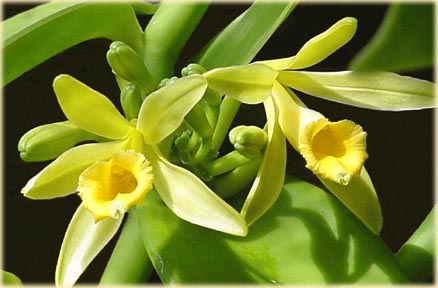
Cultivation of vanilla:
Did you know that vanilla is actually a fleshy climbing vine from the orchid family, the largest family of flowering plants in the world? It can get up to 100 feet long. The vanilla fruit is the only edible fruit of the entire orchid family. There are about 150 varieties of vanilla in the world, although there are only two types that are actually used in the food and perfumes that you use at home.
 The
vanilla planifolia is a tropical, evergreen, leafy, and somewhat fleshy
vine, growing under a canopy of support trees. The plant is sustainable
within a 20-degrees band around the equator. Vanilla vines require three
years before they bear fruit. Each spring the plant bears small, pale
greenish-yellow orchids. The flowers that produce the vanilla fruit are
large, have a yellow greenish color, and occur in groups of twenty or more.
They only last one day before they die. Like most orchids, the blossoms grow along stems
branching from the main vine. The buds, growing along the 6 to 10 inch
stems, bloom and mature in
The
vanilla planifolia is a tropical, evergreen, leafy, and somewhat fleshy
vine, growing under a canopy of support trees. The plant is sustainable
within a 20-degrees band around the equator. Vanilla vines require three
years before they bear fruit. Each spring the plant bears small, pale
greenish-yellow orchids. The flowers that produce the vanilla fruit are
large, have a yellow greenish color, and occur in groups of twenty or more.
They only last one day before they die. Like most orchids, the blossoms grow along stems
branching from the main vine. The buds, growing along the 6 to 10 inch
stems, bloom and mature in  sequence,
each at a different time. Without pollination the blossom wilts and falls,
and no vanilla bean can grow. Each flower must be pollinated within
12 hours of opening. The only insect capable of pollinating the blossom
is the Melipona, a bee, native only to Mexico. All vanilla commercially grown today
is pollinated by hand.
sequence,
each at a different time. Without pollination the blossom wilts and falls,
and no vanilla bean can grow. Each flower must be pollinated within
12 hours of opening. The only insect capable of pollinating the blossom
is the Melipona, a bee, native only to Mexico. All vanilla commercially grown today
is pollinated by hand.  A
small splinter of wood or a grass stem is used to lift the rostellum or
flap out of the way so that the overhanging anther can be pressed against
the stigma to effect self pollination. On the plantations, girls pollinate
hundreds of flowers by hand with their “needles”. A healthy
vine should produce about 100 pods per year, however our growers are careful
to pollinate only a few of the blossoms on each stem. Over pollination
results in diseased and unhealthy inferior beans.
A
small splinter of wood or a grass stem is used to lift the rostellum or
flap out of the way so that the overhanging anther can be pressed against
the stigma to effect self pollination. On the plantations, girls pollinate
hundreds of flowers by hand with their “needles”. A healthy
vine should produce about 100 pods per year, however our growers are careful
to pollinate only a few of the blossoms on each stem. Over pollination
results in diseased and unhealthy inferior beans.
The vanilla bean grows quickly
on the vine but is not ready for harvest until maturity- approximately
nine months in order to completely develop their signature aroma. However,
when the beans are harvested, they have neither flavor nor fragrance. They
develop these distinctive properties during the preparation. Harvesting vanilla
beans is as labor intensive as pollinating
the blossoms. Each bean ripens at its own time, requiring a daily harvest
for 3 or 4 weeks. To ensure the finest flavor from every bean, each individual
pod must be picked by hand just as it splits. The flavor components are bound as glycosides and must be set
free by enzymatic reaction. When the beans are harvested,
they are treated with hot water or heat and are then placed in the sun every
day and sweat in rolled blankets at night for weeks to months until they have shrunk to 20% of their original size.
It is crucial that the vanilla bean not
be harvested until it is yellow on the tip and is beginning to split on
the end. If picked too green the bean will lack flavor and develop molds
that will eventually cause it to rot. After this process is complete, the
beans are sorted for size and quality. Then they will rest for a month or
two to finish developing their full flavor and fragrance. The entire
curing process takes about three months.


 During
the curing, an enzyme converts the precursors to the rich flavoring elements that
make up more than 170 flavoring components of properly grown and cured
bean. Four pounds of green beans make only one pound of dried vanilla. The
vanilla is completely cured when the proper moisture content is reached,
and the beans have darkened to a sweet, rich aroma. The beans are then
inspected for quality, hand sorted for length and shipped.
During
the curing, an enzyme converts the precursors to the rich flavoring elements that
make up more than 170 flavoring components of properly grown and cured
bean. Four pounds of green beans make only one pound of dried vanilla. The
vanilla is completely cured when the proper moisture content is reached,
and the beans have darkened to a sweet, rich aroma. The beans are then
inspected for quality, hand sorted for length and shipped.